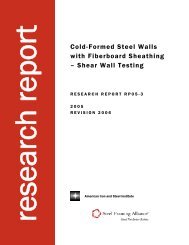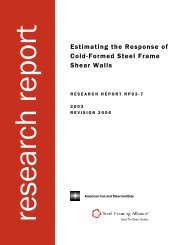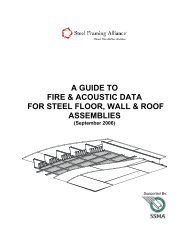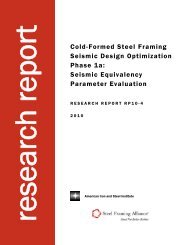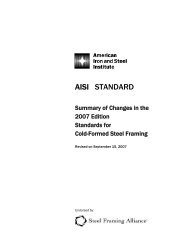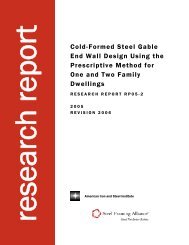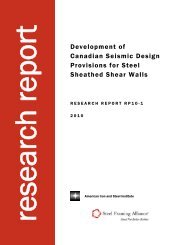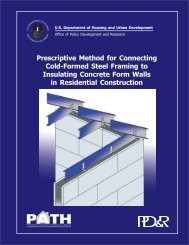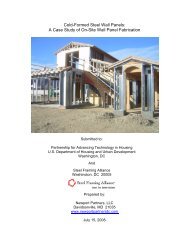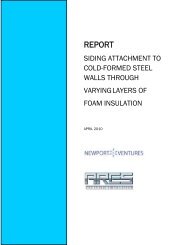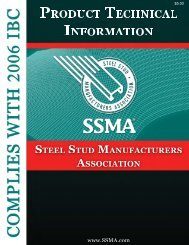Hybrid Wood and Steel Details– Builder's Guide
Hybrid Wood and Steel Details– Builder's Guide
Hybrid Wood and Steel Details– Builder's Guide
You also want an ePaper? Increase the reach of your titles
YUMPU automatically turns print PDFs into web optimized ePapers that Google loves.
<strong>Hybrid</strong> <strong>Wood</strong> <strong>and</strong> <strong>Steel</strong> <strong>Details–</strong>Builder’s <strong>Guide</strong>3 Materials3.2.1 Basic Characteristics of<strong>Wood</strong> <strong>and</strong> Lumber<strong>Wood</strong> is a natural material. Therefore, its properties <strong>and</strong>behavior are as varied as the number of species, growthconditions, <strong>and</strong> other factors governing the physicalcharacteristics of a tree (i.e., wood) or lumber (i.e., solidsawn members made from a tree). For this reason, thewood industry places much attention on managing thematerial’s natural variability in the processing of solid sawnlumber <strong>and</strong> other wood products for a variety of end uses.The process starts with a growth management <strong>and</strong>harvesting strategy for forests that include privately <strong>and</strong>publicly held l<strong>and</strong>s <strong>and</strong> resources. It ends with the finalassignment of a “grade” to a milled (i.e., solid sawn) piece oflumber in accordance with various st<strong>and</strong>ards <strong>and</strong> practicesthat provide some degree of uniformity <strong>and</strong> consistency inappearance <strong>and</strong> structural properties as realized by the enduser (i.e., builders <strong>and</strong> designers).The main characteristics of an individual piece of lumber thatdetermine its properties <strong>and</strong> behavior in end use include:• Species• Density• Natural featuresSpecies <strong>and</strong> density of wood are the primary attributes thatdistinguish one piece of lumber from another. For example,a given species will determine the physiologicalcharacteristics <strong>and</strong> range of wood density that can beexpected for a given tree or piece of lumber. Density isimportant because it is strongly correlated with the strengthproperties of lumber. However, other factors can override thisgeneral correlation, such as knots (i.e., locations where treelimbs tie into the main stem or trunk of the tree). Theoverriding factors are broadly classified as natural featuresor “defects” in comparison to a “perfect” piece of lumber(i.e., one that is straight-grained <strong>and</strong> clear of knots).Therefore, visual grading rules for assignment of lumberstructural properties are keyed to categorizing degrees ofdefects relative to their impact on the performance of a pieceof lumber.<strong>Wood</strong> is a plant material (i.e., cellulose) <strong>and</strong> its properties<strong>and</strong> behavior are closely tied to moisture. Therefore,moisture is also considered in the processing <strong>and</strong> end useof lumber. For example, wood shrinks <strong>and</strong> swells withchanging moisture content. As a result, a piece of lumbercan experience warping <strong>and</strong> splitting as it dries. In general,lumber strength <strong>and</strong> dimensional stability depends onmoisture content. For this reason, structural-use lumber isrequired to have a maximum moisture content of about 19percent (i.e., cured by air drying), above this amount ofmoisture, decay is possible (i.e., fungal growth may besupported). In addition, given that lumber generally dries toless than 12 percent moisture content when used inside abuilding, excessive shrinkage can occur, causing movementof parts of a building as the lumber equilibrates to its newenvironment. To prevent excessive shrinkage, lumber isfrequently specified as kiln-dried (i.e., designated as KD ona grade stamp) to a lower moisture content such as 15percent or less.3.2.2 Lumber Applications<strong>and</strong> SizesLumber is divided into three main size categories based ondifferences in intended application:Boards1 to 1 ½ inches thick2 inches <strong>and</strong> widerDimension Lumber2 to 4 inches thick2 inches wideTimbers5 inches <strong>and</strong> thicker5 inches <strong>and</strong> widerBoards are the thinnest lumber size category <strong>and</strong> aregenerally used for nonstructural applications such asshelving or furring. The use of boards for applications suchas floor, roof, <strong>and</strong> wall sheathing has practically disappearedfrom practice due to the introduction <strong>and</strong> widespreadadoption of wood structural panel products (e.g., plywood) inthe 1950s.Dimension lumber is commonly used for residential <strong>and</strong> lightcommercial framing (i.e., conventional light frame woodconstruction). For example, a 2x4 wood stud (wall framing),a 2x10 wood joist (floor framing), <strong>and</strong> a 2x6 rafter or 2x4wood truss (roof framing) are all typical applications ofdimension lumber. Timbers are used where larger beams orcolumns are required to resist heavier loads (e.g., timberframe construction, timber bridges, <strong>and</strong> so forth).Table 3.5 provides nominal sizes of structural lumberaccording to intended application categories. Grades oflumber for the different categories are also shown <strong>and</strong> arediscussed in the next section.10



